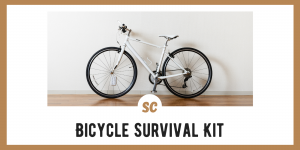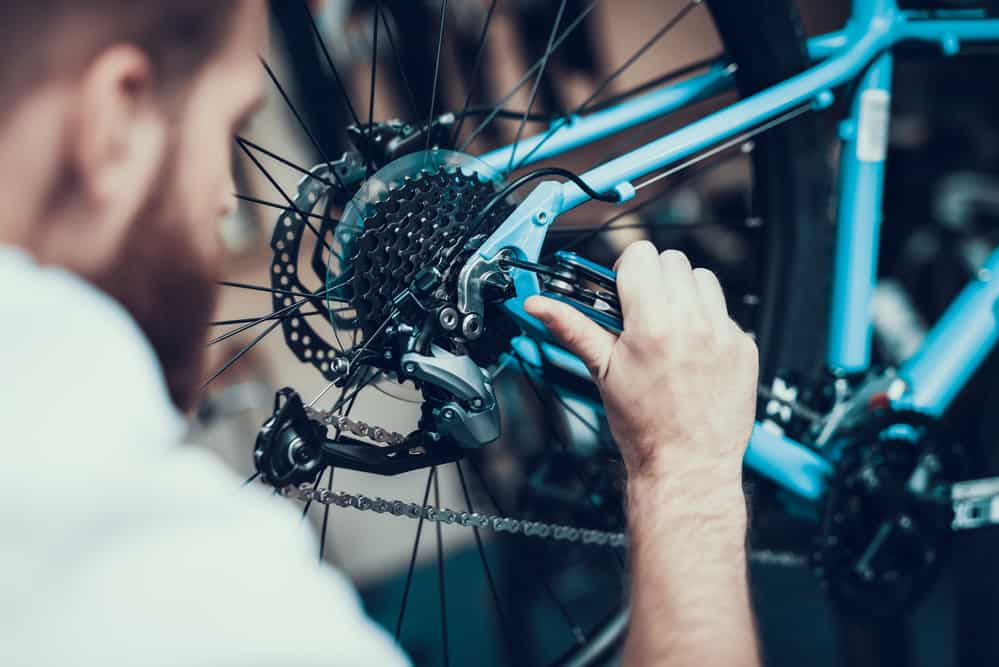Bicycles are a lot of fun to ride for people of all ages. They are fun for solo rides or with friends and family.
They also make a darn good bug-out vehicle.
Their design allows them to go where other vehicles cannot, which means it is easy to find yourself off the beaten path and away from help should you need it.
Bicyclists also must contend with other motorists and potentially dangerous environments. This is why it is always a good idea to have a survival kit with emergency supplies on your bike.
Depending on if you ride in a more urban setting or the outdoors, some gear may better than others, but most of the supplies in the following kit work well no matter where you are.
SKIP AHEAD
Survival Kit Items
Maintenance and Repair
As with any vehicle, your emergency kit should have tools and supplies for repairing common problems.
If your bike breaks down, having a repair kit can mean the difference between getting back to safety or being stranded.
A flat tire is probably going to be one of the most common problems you will encounter with a bike. Fixing this issue is pretty easy, straightforward, and does not require a lot of supplies.
To deal with a flat tire, a patch kit, extra inner tubes, an air pump, and a multitool or bike tool will need to be in your kit.
It is in your best interest to know this skill and know it well, especially if you ride in the outdoors. If you are unfamiliar with how to fix a flat tire there are a lot of great video tutorials online.
Additionally, your local bike shop is a great source of information and they will most likely show you how to deal with bike maintenance issues.
Signaling
A bicycle is a small vehicle and therefore difficult to see. To help make the bike more visible, it is a good idea to outfit it with reflectors, blinkers, and lights. These are preventive means of being seen but can also make you more visible during an emergency.
A kit should also include other means of being seen that can be used during an emergency. This can include brightly colored marking tape or flags, a reflective vest that can be worn, signal flares, a signal mirror, and a flashlight.
Multitool
This should already be in your repair kit but if it is not, then add it. A multitool allows you to carry many tools in a small, lightweight package.
They can help with bike adjustments, repairs, and in a worst-case scenario, they can be used to cannibalize the bike for additional supplies.
For this type of kit, it is recommended to have a plier basked multitool like a Leatherman. The pliers and wire cutter are useful for adjustments and for taking things apart. A multitool is also extremely versatile for many other emergency and survival-related tasks.
Water
Most cyclists have their own way of carrying water, whether that be a bottle clipped onto the frame or through a hydration bladder that they wear.
Without being able to refill, these options are good for short excursions. However, since these two containers cannot carry a lot of water, it would be helpful to pack a water filter and purification tablets.
A water filter and purification tablets can be used in unison with the containers to keep you hydrated much longer during an emergency.
Fire
Having a fire in a survival situation offers a lot of benefits. From keeping warm to boiling water to signaling for help, the advantages of creating fire cannot be underestimated.
A small portable fire kit can help you get a fire started even in tough conditions.
At a minimum, a lighter, stormproof matches, or a ferrocerium rod should be carried in the kit. A fire-starting aid is also a great item to have for getting a fire started quickly.
Food
Unless you plan on taking an extended bike trip, packing a lot of food for an everyday ride may be unnecessary. It will add weight, take up space, and rotating it out will need to be monitored.
But that is not to say you should not pack any food. Keeping your energy up by having something to snack on is always beneficial.
Long-lasting food that does not require refrigeration or cooking is preferred, such as trail mixes, granola, or energy bars.
Rehydration Salts
Riding a bike can be a lot of work, particularly when cycling across rough terrain. It requires a lot of energy and causes a lot of sweating.
To help replenish what is lost, packets of hydration salts or electrolyte mixes are easily added to a container of water. They are easily carried in a kit and can make a big difference in how you feel.
Navigation
Smartphones are exceptionally easy to use and offer some great navigational tools like GPS, and maps that can be downloaded for offline use. They can also become easily inoperable or broken.
In addition to your tech, a paper map of the region you will be traveling in and a compass should be packed into your kit.
Staying Warm and Dry
Other than the fire kit it is a good idea to also pack an emergency blanket or bivvy. They are extremely lightweight, work well, and do not take up much space. another item that is just as easy to pack is a rain poncho. Staying dry, especially in cooler temperatures, is critical.
Carrying It All
Unless you are pulling a small trailer, space is limited on a bicycle but there are a few creative options for optimizing what space there is. Here are a few ways to carry supplies on your bike. Choose the one that best suits you or use a combination of all the options.
- Under the seat saddlebag. These are small bags that mount directly under the seat.
- Front frame packs. These bags typically mount on the top tube, in front of the rider.
- Rear seat bags. These bags are of decent size and mount on a bracket above the rear wheel.
- Triangular storage bags. As the name suggests, these are triangular-shaped bags that fit inside the middle of the frame below the top tube.
- Backpack. Lastly, the kit and additional supplies can always be put in a small backpack and carried on your person.
Wrap Up
Bicycling is great exercise and a fun activity. But no matter where you go for a ride, around town, at a park, or a trek in the outdoors, it is important to always be prepared with an emergency survival kit.
What items do you like to carry when bicycling? Sound off in the comment section below and let us know. Thanks for reading and stay prepared!





